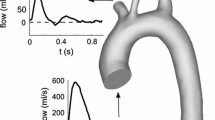Abstract
Aortic coarctation is a local constriction of the aorta that may severely affect haemodynamics. It is therefore important to quantify these effects. Using Bernoulli's equation and the momentum theorem, the pressure drop is described including the pressure recovery distal to the coarctation and the effects of collateral flow; both laminar and turbulent. Assuming the coarctation and collaterals to be stiff, a quadratic relationship between flow and pressure drop is expected for flow through the coarctation and for turbulent collateral flow. For laminar collateral flow, a linear relationship is expected. The coarctation flow was studied in a model consisting of a rigid tube with local constriction, connected to a flooded-level tank, containing a 36 per cent by weight solution of sucrose, with a viscosity equivalent to that of blood at body temperature. The pressure drop across the constriction showed a quadratic relationship to flow in agreement with theoretical expectations. Pressure recovery in this model was very slight (0–4 mm Hg). Nine patients with aortic coarctation were catheterised. Cardiac output and pressure drop across the coarctation were measured at rest and during supine cycle exercise at two different workloads. The relationship between mean pressure drop and cardiac output tended to be either ‘parabolic’ or, in some cases, approximately linear, suggesting that the flow situation in aortic coarctation can be quantified by expressions that either linearly or quadratically relate pressure and flow.
Similar content being viewed by others
References
Beekman, R. H., Rocchini, A. P., Behrendt, D. M. andRosenthal, A. (1981) Reoperation for coarctation of the aorta.Am. J. Cardiol.,48, 1108–1114.
Brom, A. G. (1965) Narrowing of the aortic isthmus and enlargement of the mind.J. Thorac. Cardiovasc. Surg.,50, 166–180.
Campbell, M. (1970) Natural history of coarctation of the aorta.Br. Heart J.,32, 633–640.
Clark, C. (1976a) The fluid mechanics of aortic stenosis. I. Theory and steady flow experiments.J. Biomech.,9, 521–528.
Clark, C. (1976b) The fluid mechanics of aortic stenosis. II. Unsteady flow experiments. —Ibid.,9, 567–573.
Crafoord, C. andNylin, G. (1945) Congenital coarctation of the aorta and its surgical treatment.J. Thorac. Surg.,14, 347–361.
Fung, Y. C. (1984)Biodynamics, Springer Verlag, New York, 100.
Gross, R. E. andHufnagel, C. A. (1945) Coarctation of the aorta.New Engl. J. Med.,233, 287–293.
Massey, B. S. (1989)Mechanics of fluids. 6th edn. Van Nostrand Reinhold, London.
Merrit, H. E. (1967)Hydraulic control systems. John Wiley & Sons, New York.
Potain, P. C. (1892) Rétrécissement congénital de l'aorte.Gazette Hebdomadaire de Méd. et de Chir.,25, 292–295.
Reifenstein, G. H., Levine, S. A. andGross, R. E. (1947) Coarctation of the aorta. A review of 104 autopsied cases of the ‘adult type’, 2 years of age or older.Am. Heart J.,33, 146–168.
Riemenschneider, T. A. andLinde, L. M. (1979) Aorta, coarctation. InBirth defects compendium, 2nd edn.Bergsma, D. (Ed.), Macmillan Press Ltd., London, 103–104.
Sanders, S. P., MacPherson, D. andYeager, S. Y. (1986) Temporal flow velocity profile in the descending aorta in coarctation.J. Am. Coll. Cardiol.,7, 603–609.
Sealy, W. C. (1979) Complications following repair of coarctation of the aorta. InComplications of intrathoracic surgery.Cordell, R. A. andEllicon, R. G. (Eds.), Little, Brown & Co., Boston 193–200.
Sykes, B. J., Kreuzer, D. W. andSchenk, W. G. (1972) A new method for preparation of experimental coarctation of the aorta.Surg. Gynec. Obstet.,135, 541–544.
Yoganathan, A. P., Cape, E. G., Sung, H.-W., Williams, F. andJimoh, A. (1988) Review of hydrodynamic principles for the cardiologist; applications to the study of blood flow and jets by imaging techniques.J. Am. Coll. Cardiol.,12, 1344–1352.
Author information
Authors and Affiliations
Rights and permissions
About this article
Cite this article
Engvall, J., Ask, P., Loyd, D. et al. Coarctation of the aorta—a theoretical and experimental analysis of the effects of a centrally located arterial stenosis. Med. Biol. Eng. Comput. 29, 291–296 (1991). https://doi.org/10.1007/BF02446711
Received:
Accepted:
Issue Date:
DOI: https://doi.org/10.1007/BF02446711




